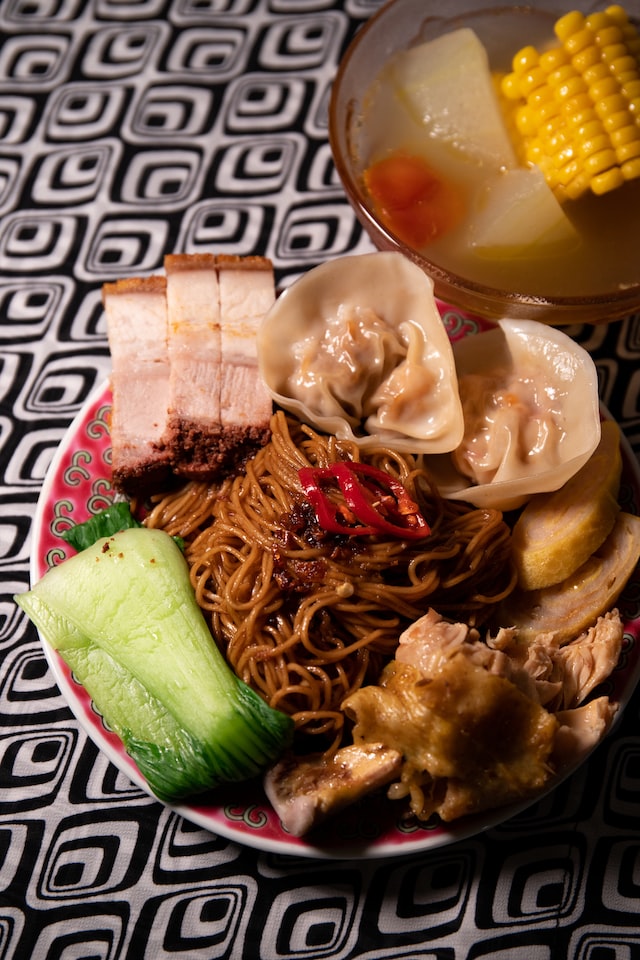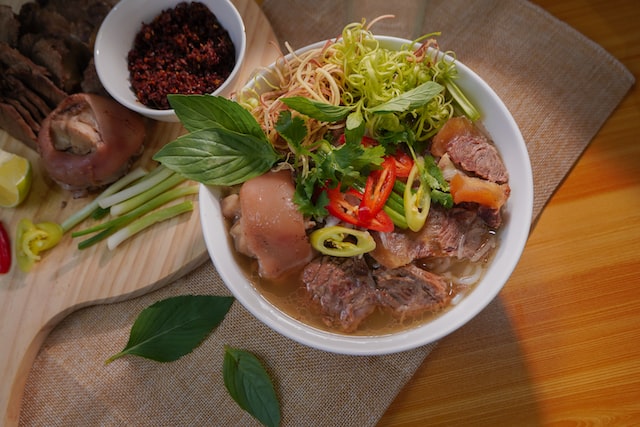Introduction
Spices are the most important ingredient in many of the world’s cuisines. They give food its taste and aroma, making it even more delicious! Spices come from plants native to different regions of the world; some are used for medicinal purposes, while others have health benefits such as lowering cholesterol or improving digestion.
.gif) |
Hot Pot GIF |
SYNOPSIS
Spices and herbs vary greatly from culture to culture. Spices are grown in specific regions of the world. Most spices are very healthy and some have medicinal qualities. If you like to cook, it’s fun to explore many different spices and herbs.
 |
| Photo by Laura Cortesi on Unsplash |
Spices are used in cooking to add flavor, but they can also be used as medicine. Some spices have medicinal qualities, like cinnamon and cloves that grow in India. Other spices come from trees worldwide, like cumin which grows in Syria and Iran. Spice trees produce seeds that have been dried and ground into powder for use as a spice.
 |
| Photo by Mahmoud Sulaiman on Unsplash |
Spice known as cinnamon is derived from the bark of trees that are indigenous to Sri Lanka and India. Cinnamon is very healthy, as it lowers cholesterol and helps regulate blood sugar. It’s also tasty and can be used in many different types of cooking.
 |
| Photo by Urip Dunker on Unsplash |
Cinnamon is a spice that is made from the bark of plants that are indigenous to Sri Lanka and India. Cinnamon is very healthy, as it lowers cholesterol and helps regulate blood sugar. It’s also tasty and can be used in many different types of cooking.
.jpg) |
| Photo by Prchi Palwe on Unsplash |
Cinnamon has lots of health benefits:
It has antimicrobial properties that help prevent infection in your mouth and throat
It improves brain function by enhancing cognitive function (this means you think more clearly)
Cinnamon may help lower your risk for heart disease by lowering cholesterol levels
Cloves are the dried parts of the clove tree, which is native to Indonesia. Cloves are used in Indian cooking, especially curry dishes. Cloves are very high in antioxidants.
 |
| Photo by VD Photography on Unsplash |
Cloves are the dried parts of the clove tree, which is native to Indonesia. Cloves are used in Indian cooking, especially curry dishes. Cloves are very high in antioxidants.
Cloves can be used to flavor many different types of food including white rice, black beans and brown rice (all with cinnamon), pasta sauces, and even ice cream! Cinnamon comes from the bark of trees native to India and Sri Lanka (cinnamon is also known as cassia). Cinnamon has been used for thousands of years by people all over Asia as an ingredient for many different recipes like tea or coffee. Cumin comes from plants that grow in warm climates like India - it's often added to dishes during Ramadan because it makes them taste better--and it's also good for your health too!
Saffron is the most expensive spice in the world and comes from crocus flowers grown in India, Greece, Spain, Morocco and Turkey. Saffron is often found in Indian cooking as well as Persian cooking; it also gives flavor to saffron rice. Saffron has antioxidant benefits as well as cancer-fighting properties.
 |
| Photo by Mohammad Amiri on Unsplash |
Saffron is the most expensive spice in the world and comes from crocus flowers grown in India, Greece, Spain, Morocco and Turkey. Saffron is often found in Indian cooking as well as Persian cooking; it also gives flavor to saffron rice.
 |
| Photo by Benyamin Bohlouli on Unsplash |
Saffron has antioxidant benefits as well as cancer-fighting properties.
Cumin is a spice used for cooking all over the world, especially in North African countries like Egypt and Morocco as well as India, Mexico and the United States. Cumin seeds come from plants that grow in warm climates like India; cumin seeds have anti-inflammatory properties as well as other health benefits like helping improve digestion and aiding weight loss efforts.
 |
| Photo by Umesh Soni on Unsplash |
Cumin is a spice used for cooking all over the world, especially in North African countries like Egypt and Morocco as well as India, Mexico and the United States. Cumin seeds come from plants that grow in warm climates like India; cumin seeds have anti-inflammatory properties as well as other health benefits like helping improve digestion and aiding weight loss efforts.
.jpg) |
| Photo by Sebastian Coman Photography on Unsplash |
Cumin is also known by its botanical name, Coriandrum sativum L., which means "smell of garlic." This refers to its pungent aroma when crushed or ground into powder form. The word comes from “curly” or “curlicue” because of its distinctive shape when dried out (also see oregano below).
India
 |
| Photo by Ryan Kwok on Unsplash |
You might be surprised to learn that spices weren't grown in India. In fact, it wasn't until the British started trading with India that spices began to be cultivated there. Curry powder is one of the most popular Indian dishes and can be made with many different combinations of spices. Curry powder is usually used as a base for many other dishes too, including curries and tandoori chicken (which uses a similar marinade).
 |
| Photo by Pushpak Dsilva on Unsplash |
Indian food is very spicy—not everyone likes it! However, if you do like spicy foods then Indian cuisine could become your favorite! Many different kinds of peppers are used in Indian cooking including cayenne chiles (the hottest type), black pepper flakes, or coriander seeds ground into powder form on their own but also mixed together with garlic cloves or ginger roots before being added into sauces or stews during cooking periods when they're supposed to cook longer than just once over medium heat levels."
BIRYANI GAME
 |
| Photo by Andy Hay on Unsplash |
 |
| Photo by Louis Hansel on Unsplash |
 |
| Photo by Haryo Setyadi on Unsplash |
 |
| Photo by Sanju M Gurung on Unsplash |
 |
| Photo by Juli Moreira on Unsplash |
 |
| Photo by Omkar Jadhav on Unsplash |
 |
| Photo by Mario Raj on Unsplash |
 |
| Photo by Shreyak Singh on Unsplash |
 |
| Photo by Mario Raj on Unsplash |
 |
| Photo by Shreyak Singh on Unsplash |
 |
| Photo by Umair Ali Asad on Unsplash |
 |
| Photo by Arbendra Pratap on Unsplash |
Curry powder is a mix of different spices that can be found in the market and used to make your own curry recipe. It's also a great way to get the flavor of Indian food without having to buy all the individual spices separately.
China
 |
| Photo by Element5 Digital on Unsplash |
Chinese food is one of the healthiest cuisines in the world. It's not just because it doesn't have any trans fats, but also because of the use of spices like cinnamon, turmeric, and fennel. These ingredients can be found in almost every dish you'll find at a Chinese restaurant or takeout place!
 |
| Photo by Tamanna Rumee on Unsplash |
 |
| Photo by Anurag Arora on Unsplash |
Chinese cuisine includes over 100 different spices used in cooking such as ginger (which helps with digestion), garlic (which lowers cholesterol levels), cinnamon (an anti-inflammatory), and pepper flakes (an antioxidant). On top of this list are star anise seeds which have been shown to lower blood pressure by helping regulate blood pressure levels throughout your body by acting as a vasodilator—meaning they open up arteries so that blood flow improves throughout your body!
CHINESE COOKING GAME
 |
| Photo by Amanda Lim on Unsplash |
 |
| Photo by Chester Toh on Unsplash |
 |
| Photo by Louis Hansel on Unsplash |
 |
| Photo by Mae Mu on Unsplash |
 |
| Photo by Hanxiao on Unsplash |
Chinese food can also be great for your gut health. It's not just because it's low in fat, but also because of the high fiber content in many dishes. This is especially true for noodles which contain both soluble and insoluble fiber—meaning they have both types of fiber in them!
Vietnam
 |
| Photo by Markus Winkler on Unsplash |
Vietnamese food is renowned for its vibrant flavors and fresh ingredients. Vietnamese people often eat rice with their meals. Vietnamese food is often served with fish sauce, which is made from fermented fish. The most popular foods in Vietnam are pho (a noodle soup), banh mi (a sandwich), and bun cha (grilled pork).
 |
| Photo by Jennifer Schmidt on Unsplash |
 |
| Photo by Vy Huynh on Unsplash |
 |
| Photo by Alexander Sinn on Unsplash |
The most popular foods in Vietnam are pho (a noodle soup), banh mi (a sandwich), and bun cha (grilled pork).
 |
| Photo by Taylor Kiser on Unsplash |
 |
| Photo by Yael Hofnung on Unsplash |
Fresh ingredients and strong flavors are hallmarks of Vietnamese cuisine. Vietnamese people often eat rice with their meals. Vietnamese food is often served with a fish sauce made from fermented fish. The most popular foods in Vietnam are pho (a noodle soup), banh mi (a sandwich), and bun cha (grilled pork).
Indonesia
Indonesia is a country in Southeast Asia. Indonesian cuisine is influenced by Chinese, European, and Indian cuisines. It has an archipelago with over 17,000 islands and was once ruled by great empires such as the Majapahit Empire and later the Dutch East Indies Company (VOC).
 |
| Photo by R Eris Prayatama on Unsplash |
 |
| Photo by Louis Hansel on Unsplash |
 |
| Photo by Ashwini Chaudhary(Monty) on Unsplash |
 |
| Photo by R Eris Prayatama on Unsplash |
Indonesia is now one of the world’s largest exporters of spices. Spices are used for many purposes: they can be used to flavor food, preserve food or give color to it; they may also contain vitamins or minerals that are beneficial to health. The main spices used in Indonesian cuisine are turmeric powder or paste; chili pepper spice paste; coriander seeds ground into powder form; galangal root (a type of ginger); lemongrass stalk which tastes like lemon but its taste varies depending on where it comes from since there are different types available around Indonesia; tamarind pulp made from tamarind trees found throughout Southeast Asia.
Thailand, Malaysia, and Singapore
 |
| Photo by Chinh Le Duc on Unsplash |
 |
| Photo by Jay Wennington on Unsplash |
 |
| Photo by Paras Kapoor on Unsplash |
Thai food is known for its spicy flavors, including basil and coriander. It's also known for its use of fresh herbs like mint and lemongrass. Malaysian food is influenced by Chinese, Indian and Malay cuisines. Singaporean food is influenced by Chinese, Malay, and Indian cuisines. Vietnamese cooking uses a lot of fresh herbs and vegetables as well as fish sauce, soy sauce, and rice noodles (rice noodle soup). Lemongrass and mint are common spices used in Vietnamese cooking -- but there are many others too: galangal root (or ginger), kaffir lime leaves, or lemon grass stalks can be added if you're feeling adventurous!
Spices can be used to make delicious meals.
Spices are used to flavor food, and sometimes even for medicinal purposes. They can also be used in many different types of cooking, including soups and stews. Spices come from plants like ginger and pepper that grow in specific regions of the world--India being one example. The plants have special qualities: they may have medicinal qualities or act as an anti-inflammatory agent when consumed orally; however, some spices contain chemicals that could be harmful if taken internally (i.e., turmeric).
Most people enjoy experimenting with new recipes! If you're interested in learning more about how to use spices properly - either through cooking or personal experimentation - check out our page on how to cook with spices here!
 |
| Photo by Marion Botella on Unsplash |
Spices are often used for medicinal purposes. They may be used to treat colds and fevers, reduce inflammation or help with digestion. It is important to note that using spices in this way could have negative side effects such as stomach upset or allergic reactions if the spice is taken internally.
Conclusion
Spices around the world can help you make your food taste better and be healthier. You may have never thought about using spices in your cooking before, but now that you know about some of their benefits, it’s time to start experimenting!


.gif)





0 Comments
Please do not enter spam links in the comment box.